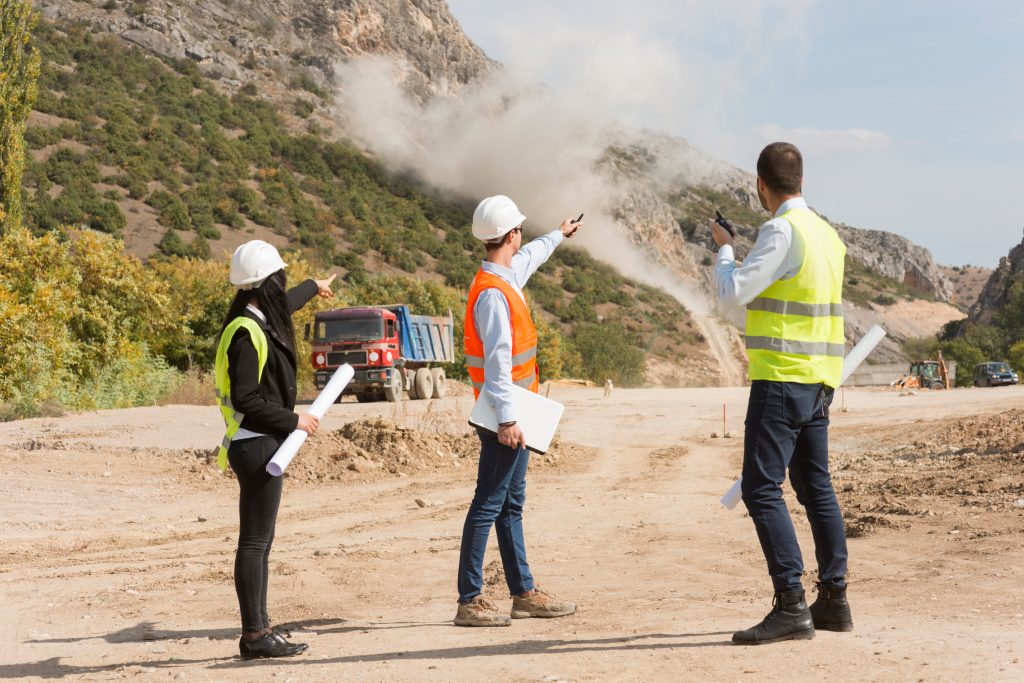
Anyone working in construction knows the industry can be full of surprises. When preparing a site for development, there are often rock deposits below the surface. In order to begin excavations for utilities or building foundations, it is a common practice to use blasting techniques to break up the rock prior to starting the excavation phase. Blasting can be an extremely dangerous exercise for workers and the surrounding area if not executed properly. As with any construction activity, it is critical to ensure a safe and secure blasting operation by planning ahead. With blasting there are three important steps to ensure it is done safely.
Step 1 Site Assessment: The first step in a successful blasting operation is conducting a site assessment to evaluate the geology and infrastructure of the area where blasting will occur. The type of rock to be blasted and the soil in the surrounding area need to be considered in order to choose the correct blasting methods. Engineers and the blaster will have to choose the right type and amount of explosive agent, blasting caps, hole depth, and pattern to be used so the rock will be broken up with the least effect on surrounding areas. Environmental considerations must also be taken to avoid negatively impacting waterways or other sensitive areas.
Step 2 Site-Specific Safety Plan: After the assessment is complete and the appropriate decisions are made, a site-specific safety plan must be developed to ensure the blasting is done safely and that all involved are trained. The plan should include procedures for before, during, and after the blast. The Blaster-in-Charge is responsible for the blasting operation and has authority to stop work at any given time. The most important feature of the pre-blast plan is to ensure that all workers are properly trained in the hazards associated with handling explosives. Only personnel with proper training are authorized by the Blaster-in-Charge to be near any area where explosives are being handled. Signs must be placed to alert others. The plan must also include procedures for transporting explosives on and off site, methods to account for explosives used and those remaining and plan for removing unused explosives from the site when complete, instead of storing them on site.
Step 3 Blasting Plan: After the holes are loaded and the charges are connected, it is time for detonation. This must be done in strict accordance with the blasting plan that includes the means of securing the blasting area. Guards should be stationed at any access point to the blasting area including pedestrian and vehicle access. They should also scan the area for potential access from other areas. If blasting is occurring near a public road, all traffic must be prevented from entering the area during blasting. The Blaster-in-Charge must clear all personnel from the blast area. Once it is determined that the area is secure, the blaster must signal an alarm prior to the shot being fired.
After the shot is detonated and debris has subsided, the Blaster-in-Charge must conduct a post-blast inspection to check the blast area for any misfire of the explosives. Any misfired charges must be properly mitigated before any unauthorized personnel are permitted in the area. Once the misfires are mitigated or if there are none, the Blaster-in-Charge will sound an all-clear alarm signaling that it is safe to return to the blast area and continue working in adjacent areas.
Blasting operations can be a daunting task especially for those who may be unfamiliar with the process. The use of explosives makes any blasting operation inherently dangerous. A well thought out plan for actions to take before, during, and after the blast and strict adherence to that plan will allow for a smooth, safe, and secure operation. As always, be sure to follow all OSHA, state, and local laws and regulations for safe blasting! Contact us for site assessment assistance, site specific safety plan development or auditing.
Written by Paul Fields, Associate Health and Safety Specialist, Construction Safety
